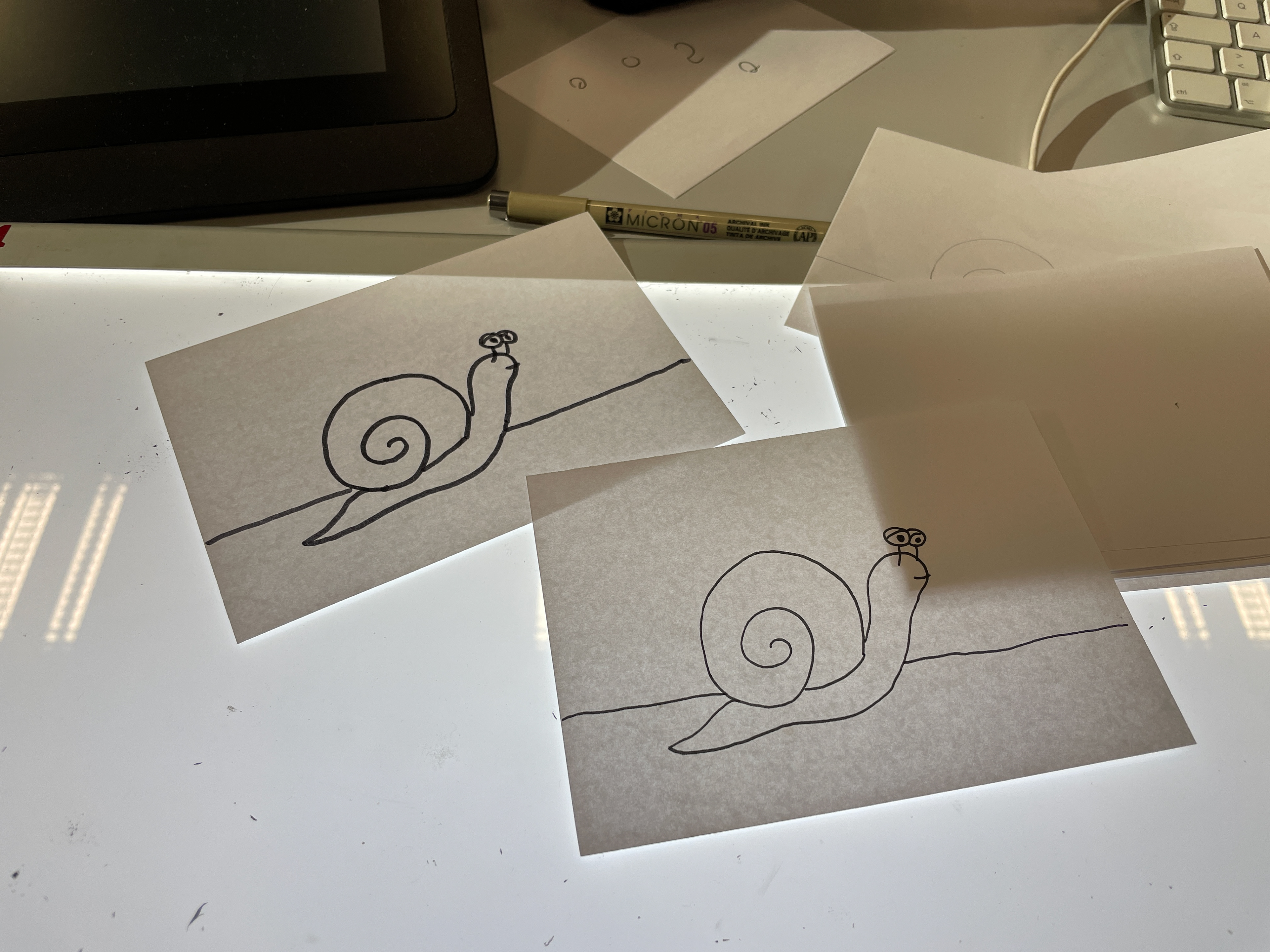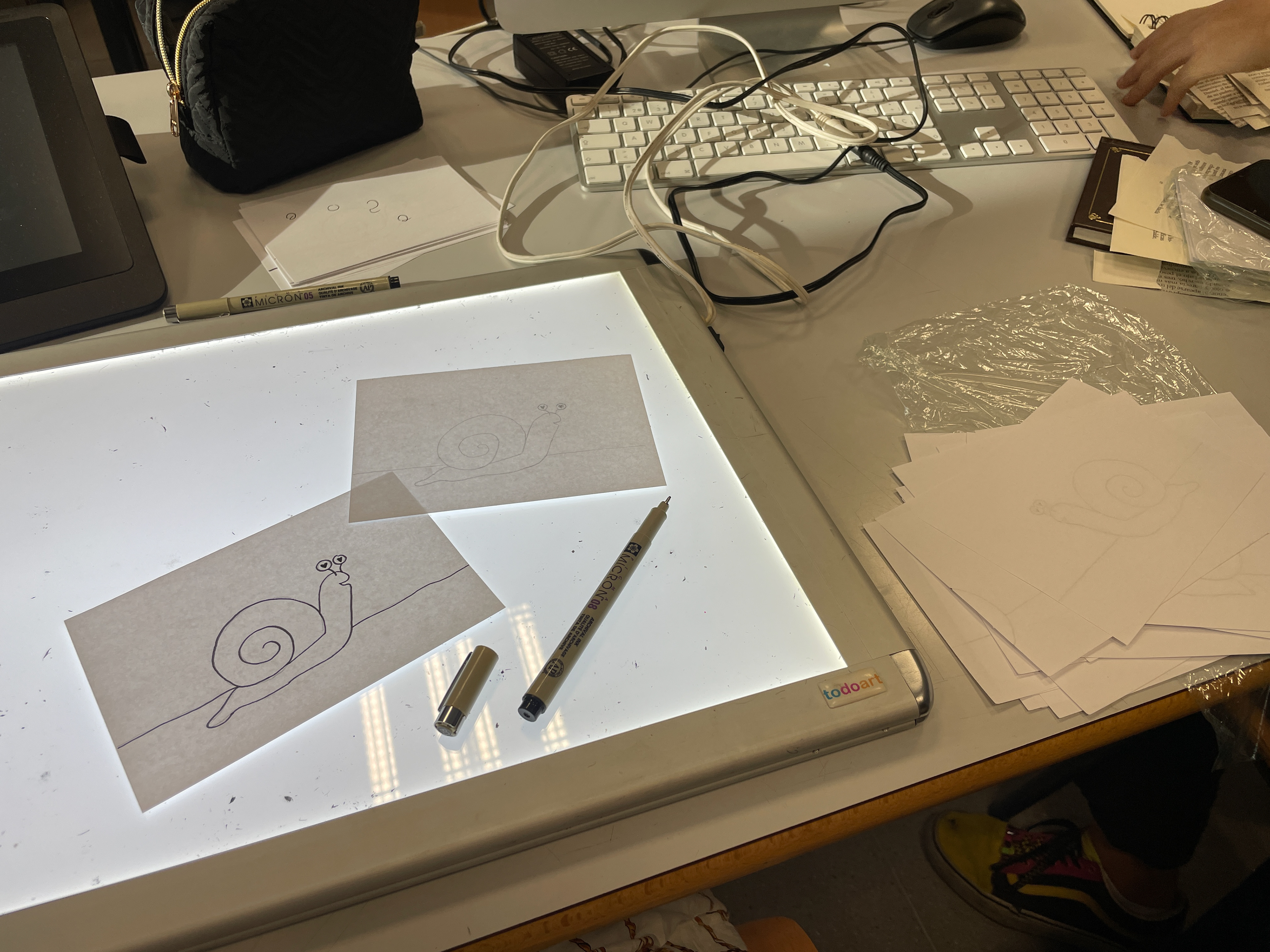This project was created in a group work during my semester abroad at the partner university UPV Universitat Politècnica de València.
This assignment was about building on the foundations from the previous exercises and planning and creating an individual animated flip book on paper. Each student had to create 24 drawings to apply the principles of animation. Then we formed teams of 7 each in which we worked together to coordinate and link the animations.
Each student created another 24 drawings to make the connections between the animations or to improve the individual animation. The goal was to end up with an animated thumb cinema that works like a GIF and has a meaningful beginning and end. Group work could be done either on physical books, which were edited as desired, or on virtual representations of books.
This assignment was about building on the foundations from the previous exercises and planning and creating an individual animated flip book on paper. Each student had to create 24 drawings to apply the principles of animation. Then we formed teams of 7 each in which we worked together to coordinate and link the animations.
Each student created another 24 drawings to make the connections between the animations or to improve the individual animation. The goal was to end up with an animated thumb cinema that works like a GIF and has a meaningful beginning and end. Group work could be done either on physical books, which were edited as desired, or on virtual representations of books.
Individual flip book
Work process and sketches
Step 1: Concept development and brainstorming
I began by developing a clear concept for my animated flipbook. I thought about what story or concept I wanted to convey and how I could integrate the animation of principles into my idea. After working in pre-formed groups to create a story together, and deciding beforehand that each individual animation would feature a ball, I made the following decision: I chose as the main character a snail named Oscar, who will interact with a ball.
I began by developing a clear concept for my animated flipbook. I thought about what story or concept I wanted to convey and how I could integrate the animation of principles into my idea. After working in pre-formed groups to create a story together, and deciding beforehand that each individual animation would feature a ball, I made the following decision: I chose as the main character a snail named Oscar, who will interact with a ball.
Step 2: My story of the individual sketch
My story is that Oscar the snail happily enters the picture. Then a ball rolls in, Oscar gets scared of the ball and shrinks. Then the snail (Oscar) looks after the ball and tries to follow quickly.
My story is that Oscar the snail happily enters the picture. Then a ball rolls in, Oscar gets scared of the ball and shrinks. Then the snail (Oscar) looks after the ball and tries to follow quickly.
Step 3: Sketching the story
I created rough sketches of my idea and divided them into 24 sections to represent the development of my story. Each sketch represented an important scene or action in my story.
I created rough sketches of my idea and divided them into 24 sections to represent the development of my story. Each sketch represented an important scene or action in my story.
Step 4: Transfer to single sheets
We were given 50 individual sheets to transfer our story to 24 sheets. First I drew two templates for my story, once the snail (Oscar) and the ball. I did this so that while transferring, I would not lose the size and proportions of either one. Finally, I transferred my sketches to these sheets as refined drawings. My utensils were first a pencil and an eraser, in order to be able to still correct mistakes.
We were given 50 individual sheets to transfer our story to 24 sheets. First I drew two templates for my story, once the snail (Oscar) and the ball. I did this so that while transferring, I would not lose the size and proportions of either one. Finally, I transferred my sketches to these sheets as refined drawings. My utensils were first a pencil and an eraser, in order to be able to still correct mistakes.
Step 5: Animation principle
I have tried to include a few animation principles: Squash & Stretch (when startled and contracted); Anticipation (before Oscar recovers); Slow In & Slow Out (with the snail tries)
I have tried to include a few animation principles: Squash & Stretch (when startled and contracted); Anticipation (before Oscar recovers); Slow In & Slow Out (with the snail tries)
Step 6: Animation simulation
To simulate the animation, I flipped through the 24 sheets to represent the movement and action of my story. I made sure that the transition between the drawings was smooth to create a realistic animation.
To simulate the animation, I flipped through the 24 sheets to represent the movement and action of my story. I made sure that the transition between the drawings was smooth to create a realistic animation.
Step 7: Story changes during the process (For group work)
As I transferred my idea and story onto the 24 sheets, I realized that this number of sheets would not be enough to give my story the appropriate expression. This presented a challenge as we were initially given the brief to limit the story to exactly 24 sheets. Because of this limitation, I decided to adapt my story slightly.
Meanwhile, our group held regular internal discussions and votes to ensure that we would have seamless transitions and a fluid storyline later in the group animation.
My revised story now looks like this: Oscar, the happy snail, enters the frame. A ball rolls in, and Oscar is at first frightened by it, contracting. Then he unexpectedly falls in love with the ball and gets hearts in his eyes. Finally, the snail Oscar disappears to introduce the new scene.
As I transferred my idea and story onto the 24 sheets, I realized that this number of sheets would not be enough to give my story the appropriate expression. This presented a challenge as we were initially given the brief to limit the story to exactly 24 sheets. Because of this limitation, I decided to adapt my story slightly.
Meanwhile, our group held regular internal discussions and votes to ensure that we would have seamless transitions and a fluid storyline later in the group animation.
My revised story now looks like this: Oscar, the happy snail, enters the frame. A ball rolls in, and Oscar is at first frightened by it, contracting. Then he unexpectedly falls in love with the ball and gets hearts in his eyes. Finally, the snail Oscar disappears to introduce the new scene.
Step 8: Erasing and final drawings
After I made the adjustments and was finally sure of the plot of the story, I traced my drawings with a black fineliner and erased the remainder.
After I made the adjustments and was finally sure of the plot of the story, I traced my drawings with a black fineliner and erased the remainder.
Step 9: Photographing with Dragon
In order to digitize my drawings and to be able to use them for the group work, I photographed my drawings in the university with a camera and the program Dragon. Afterwards the pictures were merged to a video.
In order to digitize my drawings and to be able to use them for the group work, I photographed my drawings in the university with a camera and the program Dragon. Afterwards the pictures were merged to a video.
More pictures of the work process




Overview of the individual work
Below you can see all my individual drawings. To create a smooth transition and to get a nice transition to the next scene in the group work, there were a total of 39 drawings.
Video of the individual work
This is the video resulting from the 39 images.
Reflection on my work
The task of drawing picture by picture (frame by frame) was a completely new experience for me, as I had never worked in this way before. This approach required a very detailed and step-by-step implementation that was initially foreign to me.
However, I am proud to say that my work turned out better than I had initially expected. The challenge helped me improve my animation skills and gave me a deeper understanding of the principles of frame-by-frame animation.
For future projects, I plan to pay even more attention to the character's facial expressions and gestures. I believe this will help to further enhance the emotionality and expressiveness of my animations. This experience has shown me how important the fine details in animation are to telling a story in a compelling and engaging way.
Group flip book
Coordination and connection of the individual work
The individual work was followed by the collaborative group work, which built on the knowledge gained from the earlier exercises. We then coordinated and connected the animations from the individual work in a group of 7 female students. In doing so, we linked the end of one animation to the beginning of the next, requiring each of us to make an additional about 24 drawings to make the connections and/or improve the individual animation.
The individual work was followed by the collaborative group work, which built on the knowledge gained from the earlier exercises. We then coordinated and connected the animations from the individual work in a group of 7 female students. In doing so, we linked the end of one animation to the beginning of the next, requiring each of us to make an additional about 24 drawings to make the connections and/or improve the individual animation.
Physical implementation of the group work
Our group work and camera shots were done on physical thumb cinemas (the Individuals). We were able to edit these individual thumb cinemas as we saw fit to incorporate the animations and achieve the desired effect.
Our group work and camera shots were done on physical thumb cinemas (the Individuals). We were able to edit these individual thumb cinemas as we saw fit to incorporate the animations and achieve the desired effect.
The final goal
The end goal was to create an animated group flipbook that works similarly to a GIF. This flipbook was to have a meaningful beginning and end and represent the combination of our individual animations into one continuous story. Overall, this experience was an exciting way to practically apply the principles of animation and expand our creative skills in a collaborative environment. The result was an impressive animated group book that tells a flowing story and reflects the efforts of multiple students in a collaborative project.
The end goal was to create an animated group flipbook that works similarly to a GIF. This flipbook was to have a meaningful beginning and end and represent the combination of our individual animations into one continuous story. Overall, this experience was an exciting way to practically apply the principles of animation and expand our creative skills in a collaborative environment. The result was an impressive animated group book that tells a flowing story and reflects the efforts of multiple students in a collaborative project.
Customization of the Individual Drawings
During the drawing process, I had to make some adjustments to my story due to the upcoming group work. These adjustments were to ensure that the transition to Maria's scene would be smooth. As a result, I redesigned the plot. In my revised story, the snail is frightened when the ball appears. After that, however, the snail unexpectedly falls in love with the ball because it is so fast. Finally, the snail Oscar dissolves to allow the transition to the new scene. I used a total of 39 sheets to create this animation. After drawing the basics in pencil, I carefully reworked the drawings with a black pen to bring out the subtleties and details.
This experience not only helped me better understand the principles of animation, but also showed me the flexibility and creativity needed in adapting my story for group work.
During the drawing process, I had to make some adjustments to my story due to the upcoming group work. These adjustments were to ensure that the transition to Maria's scene would be smooth. As a result, I redesigned the plot. In my revised story, the snail is frightened when the ball appears. After that, however, the snail unexpectedly falls in love with the ball because it is so fast. Finally, the snail Oscar dissolves to allow the transition to the new scene. I used a total of 39 sheets to create this animation. After drawing the basics in pencil, I carefully reworked the drawings with a black pen to bring out the subtleties and details.
This experience not only helped me better understand the principles of animation, but also showed me the flexibility and creativity needed in adapting my story for group work.
Video of the group work
Reflection on the group work
The group work proved to be extremely effective and well coordinated. Once we established the order for sequencing the individual work, we continuously coordinated with the team members who came before and after us in the sequence of animations. This was critical to ensure that there was a seamless transition between each animation.
The distribution of tasks in our group worked smoothly. We made sure that each member's opinion and contributions were valued. As an example, I was able to take care of setting up the presentation and helped present our characters in an appealing way and prepare the material for the presentation. In addition, I contributed by helping our teammates use the "Primary Pro" program to layer the videos appropriately. This experience allowed the other members to learn new skills and expand their knowledge of video editing.
When I noticed that some of my teammates were looking for suitable music for our video or animation, I decided to leave my task for a short time and suggested a website where excellent music can be found (The website is called "Epidemic Sounds“).
Since I already had an account on this site and paid monthly for it, we took the opportunity to search together for suitable music for our video. After making a preliminary selection, we came together as a whole group to make the final music selection. This illustrated how we worked effectively together in our group to achieve the best possible result.
Our teamwork was characterized by mutual respect, efficient communication, and creative collaboration, resulting in an impressive animated group project.
The distribution of tasks in our group worked smoothly. We made sure that each member's opinion and contributions were valued. As an example, I was able to take care of setting up the presentation and helped present our characters in an appealing way and prepare the material for the presentation. In addition, I contributed by helping our teammates use the "Primary Pro" program to layer the videos appropriately. This experience allowed the other members to learn new skills and expand their knowledge of video editing.
When I noticed that some of my teammates were looking for suitable music for our video or animation, I decided to leave my task for a short time and suggested a website where excellent music can be found (The website is called "Epidemic Sounds“).
Since I already had an account on this site and paid monthly for it, we took the opportunity to search together for suitable music for our video. After making a preliminary selection, we came together as a whole group to make the final music selection. This illustrated how we worked effectively together in our group to achieve the best possible result.
Our teamwork was characterized by mutual respect, efficient communication, and creative collaboration, resulting in an impressive animated group project.
.

